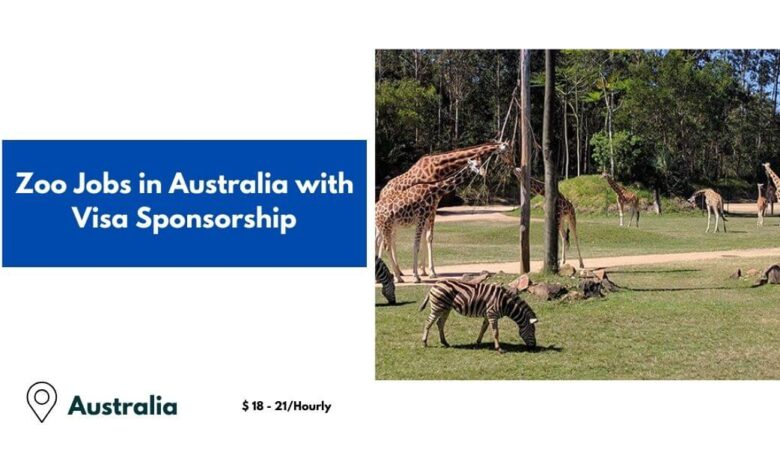Zoo Jobs in Australia with Visa Sponsorship 2025 – Apply Now

For those with a deep love for animals and an interest in conservation, working in a zoo can be a deeply rewarding experience. Zoos and wildlife parks across Australia offer a variety of career paths that allow individuals to directly engage with animals, contribute to wildlife preservation efforts, and educate the public about the importance of conservation. Whether you are starting your career or looking to specialize, this guide will provide you with detailed information about the different zoo jobs in Australia, including qualifications, salary expectations, and career advancement opportunities.
Check Also: Visa Sponsorship Hotel Jobs in Australia – Apply Now
Why Work at a Zoo in Australia?
Zoos in Australia are more than just places to see animals. They are centres for conservation, research, and education. As a zoo worker, you’ll have the opportunity to make a significant impact on the protection of endangered species and contribute to global wildlife preservation efforts. Working in a zoo allows you to:
- Contribute to wildlife conservation and species recovery programmes.
- Engage with the public to raise awareness about environmental issues.
- Work in a dynamic environment, where each day presents new challenges.
- Collaborate with like-minded professionals in the fields of zoology, veterinary science, and environmental education.
Types of Zoo Jobs in Australia:
Australia offers a wide variety of career opportunities in the zoo industry, ranging from hands-on roles with animals to behind-the-scenes positions focused on research, education, and operations. Below are some common roles in Australian zoos, along with an expanded look at each role, career growth prospects, and key qualifications.
1. Zookeeper:
Average Salary: $50,000 AUD per year
Responsibilities:
Zookeepers are at the heart of animal care in zoos. Their duties include feeding, cleaning, and providing enrichment activities for animals. They must also monitor the animals’ physical health and emotional well-being, ensuring they live in conditions that mimic their natural habitats as closely as possible. Zookeepers also interact with visitors, educating them about animal behaviours, conservation efforts, and the importance of preserving biodiversity.
Qualifications:
To become a zookeeper, you’ll generally need a bachelor’s degree in zoology, animal science, or a related field. Practical experience with animals, which can be gained through internships, volunteering, or apprenticeships, is highly valued.
Career Path:
Zookeepers can move up to more senior roles such as lead keeper, curator, or even zoo director. Further study, such as a master’s degree in wildlife management or animal behaviour, can enhance career prospects.
Real-World Example:
Emily, a zookeeper at the Taronga Zoo in Sydney, started as an animal care intern and worked her way up to a senior zookeeper role. “Working closely with endangered species like the Sumatran tiger has been the most fulfilling part of my career. It’s not just about animal care; it’s about making a real difference in conservation.”
2. Zoo Veterinarian:
Average Salary: $80,000 – $100,000 AUD per year
Responsibilities:
Zoo veterinarians are tasked with diagnosing, treating, and performing surgeries on zoo animals. They often specialize in certain species or groups of animals. Their work is essential for maintaining animal health and preventing diseases from spreading among zoo populations. They may also be involved in breeding programmes and help guide the zoo’s conservation efforts by ensuring that animals remain healthy and fit to reproduce.
Qualifications:
To become a zoo veterinarian, you’ll need a veterinary degree and relevant licensing (e.g., from the Royal College of Veterinary Surgeons in the UK or an equivalent Australian body). Additional certifications in wildlife or exotic animal care can provide an edge.
Career Path:
Zoo veterinarians can progress to specialized roles, such as head veterinarian or veterinary surgeon, and they can also participate in research projects that contribute to wildlife conservation. Some veterinarians may eventually take on administrative roles within the zoo.
Real-World Example:
Dr. Sarah, a zoo veterinarian at the Melbourne Zoo, has spent her career working with endangered species. “One of the highlights of my work is monitoring the health of the critically endangered orangutans. Our role is not only to treat injuries but to ensure the animals can thrive in their environments.”
3. Education Officer:
Average Salary: $55,000 AUD per year
Responsibilities:
Education officers design and deliver educational programmes aimed at teaching zoo visitors about conservation, wildlife, and environmental issues. They work with school groups, host events, and lead workshops that provide hands-on learning experiences. By engaging with the public, education officers help promote awareness of the zoo’s conservation goals and educate people on how they can contribute to environmental sustainability.
Qualifications:
A degree in education, biology, environmental science, or a related field is typically required. Experience in teaching or public speaking is essential, as the role involves presenting complex scientific information to a wide range of audiences.
Career Path:
Education officers can advance to positions such as education coordinator or public relations manager. They may also move into roles focusing on community outreach or conservation programs.
Real-World Example:
Tom, an education officer at the Australia Zoo, designs interactive programmes for school groups. “I love seeing kids’ faces light up when they learn about endangered species like the koala. It’s incredibly rewarding to inspire the next generation of conservationists.”
4. Operations Manager:
Average Salary: $80,000 AUD per year
Responsibilities:
Operations managers oversee the logistical aspects of running a zoo, including staffing, budgeting, scheduling, and maintenance. They ensure that the zoo operates smoothly and that all departments are functioning efficiently. Operations managers also ensure compliance with safety regulations and ensure that the zoo’s operations align with its mission and values.
Qualifications:
A degree in business administration, management, or a related field is typically required. Extensive experience in operations management, especially within a customer service or tourism setting, is highly beneficial.
Career Path:
Operations managers can move into senior leadership roles such as zoo director or head of operations. With experience, they can transition into roles at larger wildlife parks or zoos or even work internationally on conservation projects.
Real-World Example:
Sophie, an operations manager at the Adelaide Zoo, plays a key role in ensuring that the zoo’s facilities are well-maintained and safe for both animals and visitors. “Every day presents new challenges. Whether it’s handling a high visitor count or implementing a new exhibit, it’s always about improving the visitor experience and maintaining our standards.”
Additional Benefits of Zoo Jobs in Australia:
1. Professional Development:
Zoos in Australia provide opportunities for employees to further their knowledge and skills. This may include training in animal care, wildlife conservation techniques, and environmental education. Zoos often support attendance at conferences or workshops to keep staff up-to-date with the latest advancements in conservation and animal welfare.
2. Unique and Impactful Work Environment:
Zoos are dynamic, ever-evolving environments. Employees have the opportunity to work with a wide range of species and contribute to various aspects of animal care, research, and conservation. You’ll work in an atmosphere where every day can bring new experiences, from working with different animals to participating in important conservation projects.
3. Networking and Community Engagement:
Zoos often collaborate with other wildlife conservation organisations, universities, and researchers. Working at a zoo gives you the opportunity to build a professional network in the wildlife and conservation sectors. Additionally, many zoos offer community outreach programmes, allowing you to directly impact the local community and inspire others to care for wildlife.
Conclusion
A career at a zoo offers a unique opportunity to work directly with animals while contributing to conservation and education efforts. Whether you’re passionate about animal care, education, research, or operations, there are a wide range of roles available in Australia’s zoos. With the right qualifications, experience, and passion for wildlife, you can find a fulfilling career that not only supports your professional growth but also makes a meaningful impact on the preservation of species and ecosystems.
Frequently Asked Questions:
-
How many zoos are there in Australia?
Australia is home to more than 200 wildlife facilities, including large public zoos and private wildlife sanctuaries. These facilities play a crucial role in conservation and research.
-
How much do zoo workers earn in Australia?
Salaries for zoo workers in Australia vary depending on the position. For example, a zookeeper earns around $50,000 AUD per year, while a zoo veterinarian can earn between $80,000 and $100,000 AUD annually.
-
How many zoos are there in Australia?
There are more than 200 captive wildlife facilities in Australia. These include large, publicly owned or statutory zoos that exhibit both native and exotic animals. Wildlife exhibits that are part of large theme parks.



